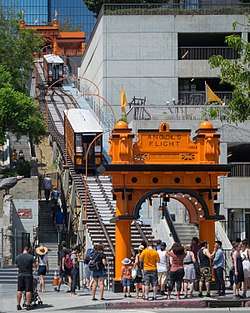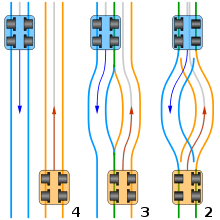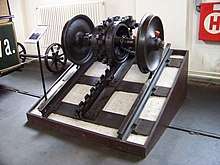Funicular
A funicular (/fjuːˈnɪkjʊlər/, /f(j)ʊ-/, /fə-/)[1] is a transportation system that uses cable-driven cars to connect points along a steep incline. By definition, a funicular uses two counterbalanced passenger cars attached to opposite ends of the same cable, which is looped over a pulley at the upper end of a track.[2][3]

_(cropped).jpg)
A funicular's two cars move in concert: as one ascends, the other descends simultaneously, an arrangement that distinguishes a funicular from other cable-guided transportation systems — e.g., a single-car inclined elevator.[2][3][4]
The term funicular derives from the Latin word funiculus, the diminutive of funis, meaning 'rope'.[5]
Operation

In a funicular both cars (or trains) are permanently connected to the opposite ends of the same cable, known as a haul rope. At the engine room at upper end of the track the haul rope runs through a system of pulleys. Sheave wheels guide the cable along the track to and from the drive mechanism and the cars. The rope pulls one car upwards while the other car descends the slope as the other end of the rope is paid out from the engine mechanics. This arrangement counterbalances the two cars and thereby reduces the energy needed to lift the ascending car. [2][6]
Typically in a modern funicular the propulsion is provided by an electric motor which is linked via a speed-reducing gearbox to a large pulley – a drive bullwheel. The bullwheel in its turn transfers its torque to the haul rope by friction. The bullwheel has two grooves: after the first half turn around it the cable returns back via an auxiliary pulley. High friction liners are used in modern installations to enhance the friction between the bullwheel and the cable.[6][7][8]
For emergency and service purposes two sets of brakes are used at the engine room: the emergency brake grips directly the bullwheel, the service brake is mounted at the high speed shaft of the gear. In a case of emergency the cars are also equipped with spring-applied, hydraulically opened rail brakes.[8]
Track layout


Early funiculars used two parallel straight tracks, four rails, with separate station platforms for each vehicle. The tracks are laid with sufficient space between them for the two cars to pass at the midpoint. Three-rail arrangement was also used to overcome the half-way passing problem.[2] Examples of this type of track layout are the Duquesne Incline in Pittsburgh, Pennsylvania, and most cliff railways in the UK.
In layouts using three rails, the middle rail is shared by both cars, like in the early version of the Petřín funicular in Prague. The three-rail layout is wider than the two-rail layout, but the passing section is simpler to build. If a rack for braking is used, that rack can be mounted higher in a three-rail layout, making it less sensitive to choking in snowy conditions.[9]
Some four-rail funiculars have the upper and lower sections interlaced and a single platform at each station. The Hill Train at Legoland, Windsor, is an example of this configuration.
The track layout can also be changed during the renovation of a funicular, and often four-rail layouts have been rebuilt as two- or three-rail layouts; e.g., the Wellington Cable Car in New Zealand was rebuilt with two rails.
Abt automatic turnout

The Swiss engineer Carl Roman Abt invented the method that allows cars to be used with a two-rail configuration. The cars, in this case, have their wheelsets of a rather unconventional design: the outboard wheel has flanges on both sides whereas the inboard wheel is unflanged.
One car has its dual-flanged wheels on the left side, so it follows the leftmost rail; the other car has it on the right side, and it follows the rightmost rail. Thus the left car always goes through the left branch of the passing loop and the right car through its right branch. The car's unflanged wheels are considerably wider than their opposites, allowing them to roll over the turnouts easily from one rail to another and above the cables.[2]
This system has no moving parts for switches and crossings, and compared with the other options it has proven to be quite reliable and cost-effective. It was first implemented by Abt in 1886 on the Lugano Città–Stazione funicular (Switzerland).[2] Since then the two-rail system with the Abt turnout have increased in popularity, so as to become a standard for modern funiculars.[7]
Water counterbalancing

A few funiculars have been built using water tanks under the floor of each car that are filled or emptied until just sufficient imbalance is achieved to allow movement. The car at the top of the hill is loaded with water until it is heavier than the car at the bottom, causing it to descend the hill and pull up the other car. The water is drained at the bottom, and the process repeats with the cars exchanging roles. The movement is controlled by a brakeman using the brake handle of the rack and pinion system engaged with the rack mounted between the rails.[2][6]
The Bom Jesus funicular built in 1882 near Braga, Portugal is one of the extant systems of this type. Another example, the funicular Neuveville - St-Pierre in Fribourg, Switzerland[10], is of particular interest as it utilizes waste water, coming from a sewage plant at the upper part of the city.[11]
Some funiculars of this type were later converted to electrical power. For example, the Giessbachbahn in the Swiss canton of Berne, opened in 1879, was originally powered by water ballast. In 1912 its energy provision was replaced by a hydraulic engine powered by a Pelton turbine. In 1948 this in turn was replaced by an electric motor.[2]
Bottom towrope

The cars can be attached to a second cable running through a pulley at the bottom of the incline in case the gravity force acting on the vehicles is too low to operate them on the slope. One of the pulleys must be designed as a tensioning wheel to avoid slack in the ropes. In this case, the winching can also be done at the lower end of the incline. This practice is used for funiculars with slopes below 6%, funiculars using sledges instead of cars, or any other case where it is not ensured that the descending car is always able to pull out the cable from the pulley in the station on the top of the incline.[9] Another reason for a bottom cable is that the cable supporting the lower car at the extent of its travel will potentially weigh several tons, whereas that supporting the upper car weighs virtually nothing. The lower cable adds an equal amount of cable weight to the upper car while deducting the same weight from the lower, thereby keeping the cars in equilibrium.
History

A number of cable railway systems which pull their cars on inclined slopes were built since the 1820s. In the second half of the 19th century the design of a funicular as a transit system emerged. It was especially attractive in comparison with the other systems of the time as counterbalancing of the cars was deemed to be a cost-cutting solution.[2]
The first line of the Funiculars of Lyon (Funiculaires de Lyon) opened in 1862, followed by other lines in 1878, 1891 and 1900. The Budapest Castle Hill Funicular was built in 1868–69, with the first test run on 23 October 1869. The oldest funicular railway operating in Britain dates from 1875 and is in Scarborough, North Yorkshire.[12] In Istanbul, Turkey, the Tünel has been in continuous operation since 1875 and is both the first underground funicular and the second-oldest underground railway. It remained powered by a steam engine up until it was taken for renovation in 1968.[13]
Until the end of the 1870s, the four-rail parallel-track funicular was the normal configuration. Carl Roman Abt developed the Abt Switch allowing the two-rail layout, which was used for the first time in 1879 when the Giessbach Funicular opened in Switzerland.[9]
In the United States, the first funicular to use a two-rail layout was the Telegraph Hill Railroad in San Francisco, which was in operation from 1884 until 1886.[14] The Mount Lowe Railway in Altadena, California, was the first mountain railway in the United States to use the three-rail layout. Three- and two-rail layouts considerably reduced the space required for building a funicular, reducing grading costs on mountain slopes and property costs for urban funiculars. These layouts enabled a funicular boom in the latter half of the 19th century.
In 1880 the funicular of Mount Vesuvius inspired the Italian popular song Funiculì, Funiculà. This funicular was destroyed repeatedly by volcanic eruptions and abandoned after the eruption of 1944.[15]
Inclined elevator
.jpg)
An inclined elevator is not a funicular, since its cars operate independently on the slope, not in interconnected pairs.[3]
Notably, Paris' Montmartre Funicular is today a funicular in name only. Its formal title is a relic of its earlier configuration, namely when its two cars originally operated in a counterbalanced, interconnected pair, always moving in opposite directions in concert, thus meeting the definition of a funicular. The system now uses two independently operating cars that can each ascend or descend on demand, qualifying as a double inclined elevator, but retaining the term "funicular" in its title as a historical, albeit misleading, reference.[16][17][4]
Exceptional examples
According to the Guinness World Records, the smallest public funicular in the world is the Fisherman's Walk Cliff Railway in Bournemouth, England, which is 39 metres (128 ft) long.[18][19]
Stoosbahn in Switzerland, with a maximum slope of 110% (47.7°), is the steepest funicular in the world.[20]
The city of Valparaiso in Chile used to have up to 30 funicular elevators (Spanish: ascensores). The oldest of them is dating from 1883. 15 remain with almost half in operation, and others in various stages of restoration.
The Carmelit in Haifa, Israel, with six stations and a tunnel 1.8 km (1.1 mi) long, is claimed by the Guinness World Records as the "least extensive metro" in the world.[21] Technically, it is an underground funicular.
The Dresden Suspension Railway (Dresden Schwebebahn), which hangs from an elevated rail, is the only suspended funicular in the world.[22]
See also
References
- "funicular, adj. and n.". Oxford English Dictionary. Retrieved 30 May 2020.
- The Giessbach Funicular with the World's First Abt Switch (PDF). The American Society of Mechanical Engineers. 2015.
- Kittelson & Assoc, Inc., Parsons Brinckerhoff, Inc., KFH Group, Inc., Texam A&M Transportation Institute, & Arup (2013). "Chapter 11: Glossary and Symbols". Transit Capacity and Quality of Service Manual. Transit Cooperative Highway Research Program (TCRP) Report 165 (Third ed.). Washington: Transportation Research Board. pp. 11–20. ISBN 978-0-309-28344-1.CS1 maint: uses authors parameter (link)
- Pyrgidis, Christos N. (4 January 2016). "Cable railway systems for steep gradients". Railway Transportation Systems: Design, Construction and Operation. CRC Press. pp. 251–260. ISBN 978-1-4822-6215-5.
- "funicular". Oxford Dictionaries. Retrieved 3 July 2018.
- Hofmann, Gottfried (1999). "Advanced funicular technology". San Francisco, Calif.: International Organization for the Study of Transportation by Rope; Internationaler Seilbahnkongress.
- "Ceremonial inauguration of the new Stoos funicular". Garaventa AG. 18 December 2017.
- Neumann, Edward S. "Cable-Propelled People Movers in Urban Environments" (PDF). Transportation Research Record. 1349: 125–132.
- Walter Hefti: Schienenseilbahnen in aller Welt. Schiefe Seilebenen, Standseilbahnen, Kabelbahnen. Birkhäuser, Basel 1975, ISBN 3-7643-0726-9 (German)
- "Funiculaire Neuveville - St-Pierre". Transports publics fribourgeois Holding (TPF) SA.
- Kirk, Mimi (16 June 2016). "A Lasting Stink: Fribourg's Sewage-Powered Funicular". The Atlantic. Retrieved 19 June 2016.
- "Blunder traps eight on cliff lift". BBC News. 24 April 2009. Retrieved 2 April 2010.
- "Tünel Kronolojisi" [Tünel Chronology] (in Turkish). İETT - Tunnel. Retrieved 7 December 2017.
- "Telegraph Hill Railroad". The Cable Car Home Page – Cable Car Lines in San Francisco. Joe Thompson. 1 July 2009. Retrieved 20 September 2009.
The Telegraph Hill Railroad was not a cable car line ...; it was a funicular railway
- Smith, Paul (March 1998). "Thomas Cook & Son's Vesuvius Railway" (PDF). Japan Railway & Transport Review.
- "MiniMetro" (PDF). LEITNER ropeways.
- "7 Line Extension Inclined Elevators" (PDF). MTA Capital Construction. 28 April 2014. Retrieved 20 June 2018.
- Guinness World Records 2015. p. 191. ISBN 978-1-908843-63-0.
- Lowbridge, Caroline. "Ten Bournemouth facts football fans might not know". BBC News. Retrieved 4 January 2016.
- Willsher, Kim (15 December 2017). "World's steepest funicular rail line to open in Switzerland". The Guardian. Retrieved 16 December 2017.
- "Carmelit Haifa – The most convenient way to get around the city". Carmelit. Retrieved 4 July 2018.
- "Schwebebahn" (in German). Dresdner Verkehrsbetriebe AG. Retrieved 5 July 2018.
External links

- Funimag, the first web magazine about funiculars

